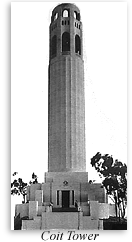 |
In the days before motorized carriages, fire engines were designed to be pulled by hand. The men of San Francisco's Knickerbocker Company, Engine Number 5, would line up along a rope and pull, like players in a tug-of-war, in order to lug an engine to a fire. On the day in 1858 when Lillie Hitchcock found them, the men were struggling. A few of their colleagues were out sick, and the combined strength of the rest was not enough to roll the engine. While a number of grown men looked on passively, 15-year-old Lillie Hitchcock jumped forward, grabbed a place on the rope and pulled.
"Come on you men! Everybody pull and we'll beat 'em!" With these words, Hitchcock implored the gawkers to step up and join the effort. Because of her, the engine did get up the hill and was the first to the fire.
Hitchcock continued to take an interest in firefighting, showing up at nearly every fire attended by the Knickerbocker Number 5. Although she could never join the fire brigade, the Company made her an honorary member and gave her a gold badge, which she wore proudly whenever she showed up to help at a fire.
Lillie was born August 23, 1843 at West Point where her father, Dr. Charles M. Hitchcock, was stationed. Hitchcock moved his family to San Francisco when she was eight years old. In those days, women did not do such things as wear pants and fight fires. For Hitchcock, whose family was entrenched in San Francisco society, such behavior was scandalous. Her father did not approve of his daughter's assiduous interest in firefighting and the gentlemen and ladies of society either ignored or humored Miss Hitchcock. Pretty soon she left off following the firemen around, but she never ceased being interested in firefighting. Even after her marriage to Howard Coit she continued to visit the firemen once in a while. If one became sick, she would appear with flowers. The firemen thought of her as their patron.
 |
After her marriage, she travelled around the world. She was a guest in the court of Napoleon III and the maharaja of India. When her travels were done, she returned to her beloved San Francisco, where for years she lived in the Palace Hotel.
When Lillie Hitchcock-Coit died July 22, 1929, at the age of 86, she left one-third of her money to the city of San Francisco. With this money the people built Coit Tower, a 180-foot tower which stands atop Telegraph Hill. Another memorial to Hitchcock-Coit and the city's firemen stands in Washington Square. It is a life-sized statue of three firemen, one of them carrying a woman in his arms.
Page created on 6/15/2004 5:02:35 PM
Last edited 1/6/2017 6:13:46 PM

My other hero is Lily Hitchcock-Coit because she supported the San Francisco firefighters and wanted to be just like them. She even smoked cigars and wore pants like the firemen. When she was walking home from school she saw that the Knickerbocker Number Five was having touble getting up a steep hill on its way to a fire. She encouraged people off the street to pull the engine to the fire.